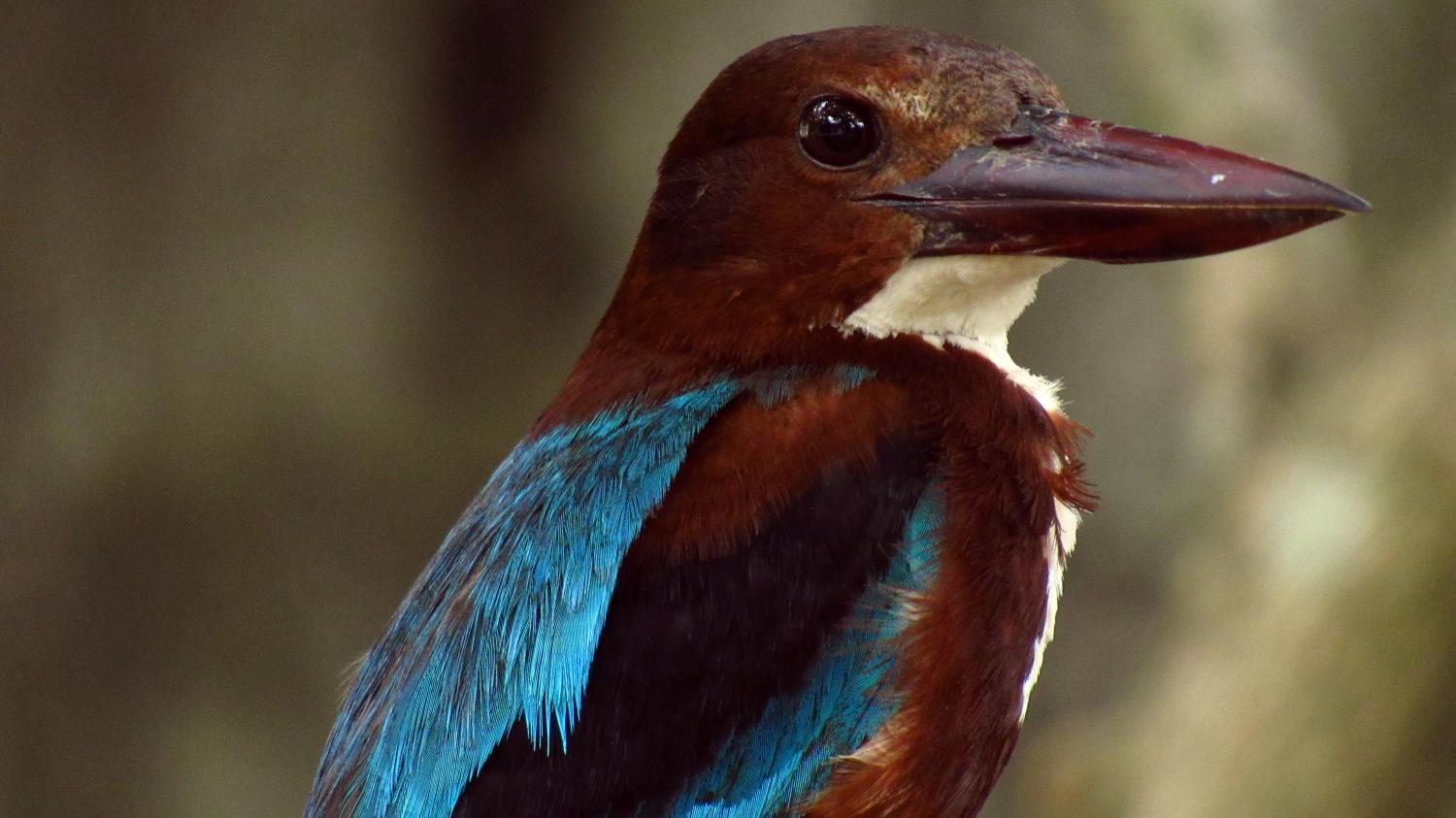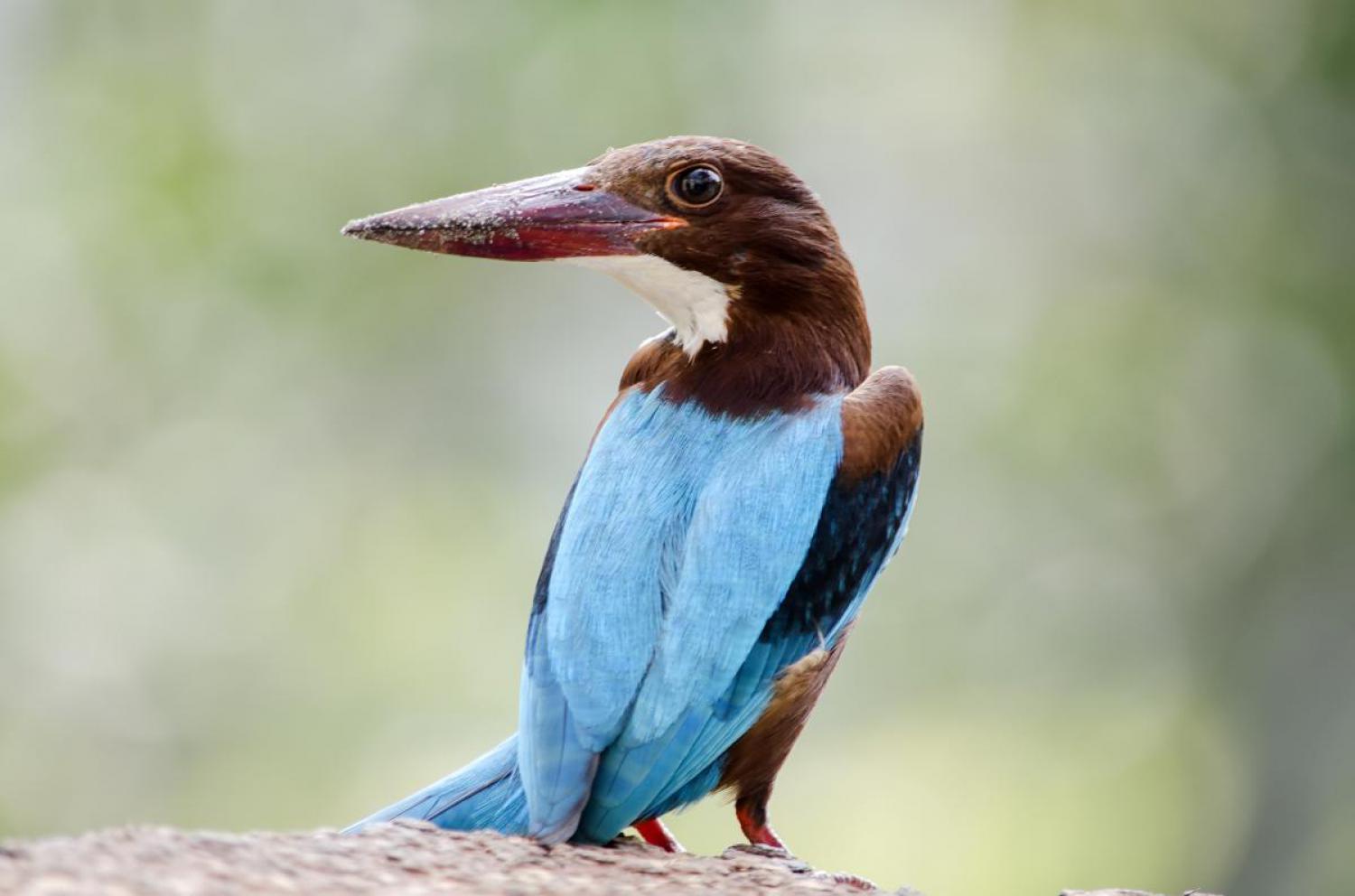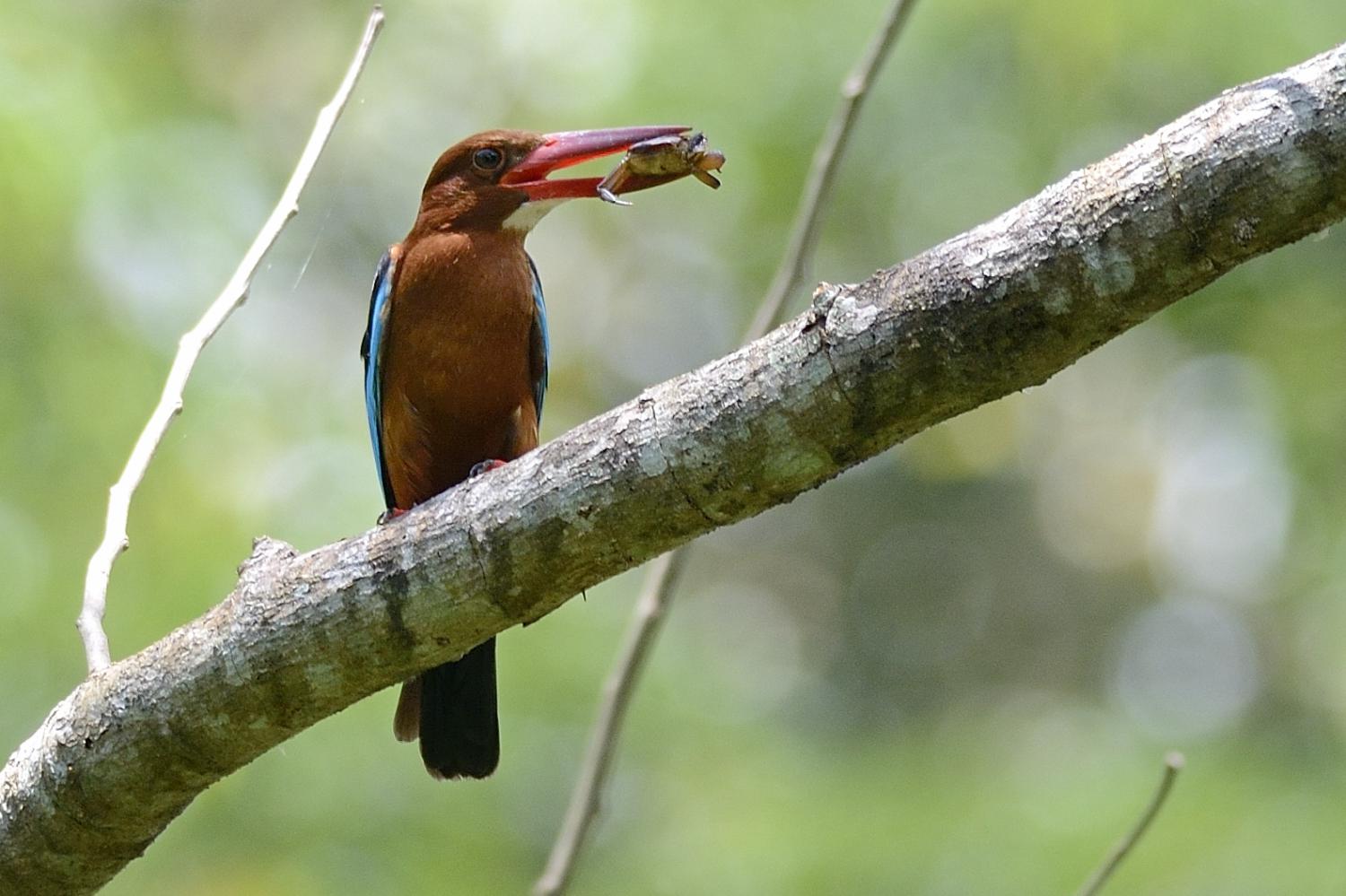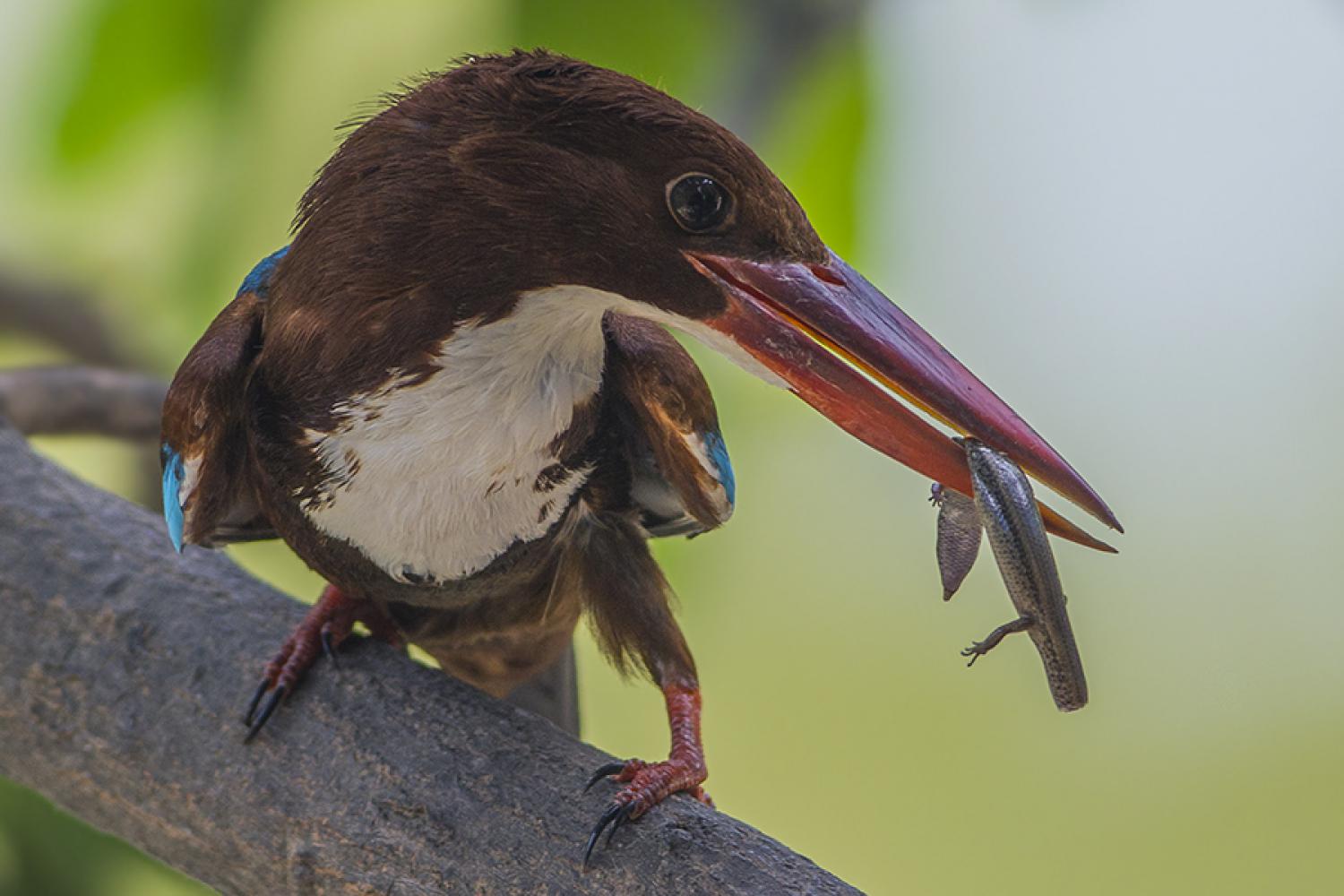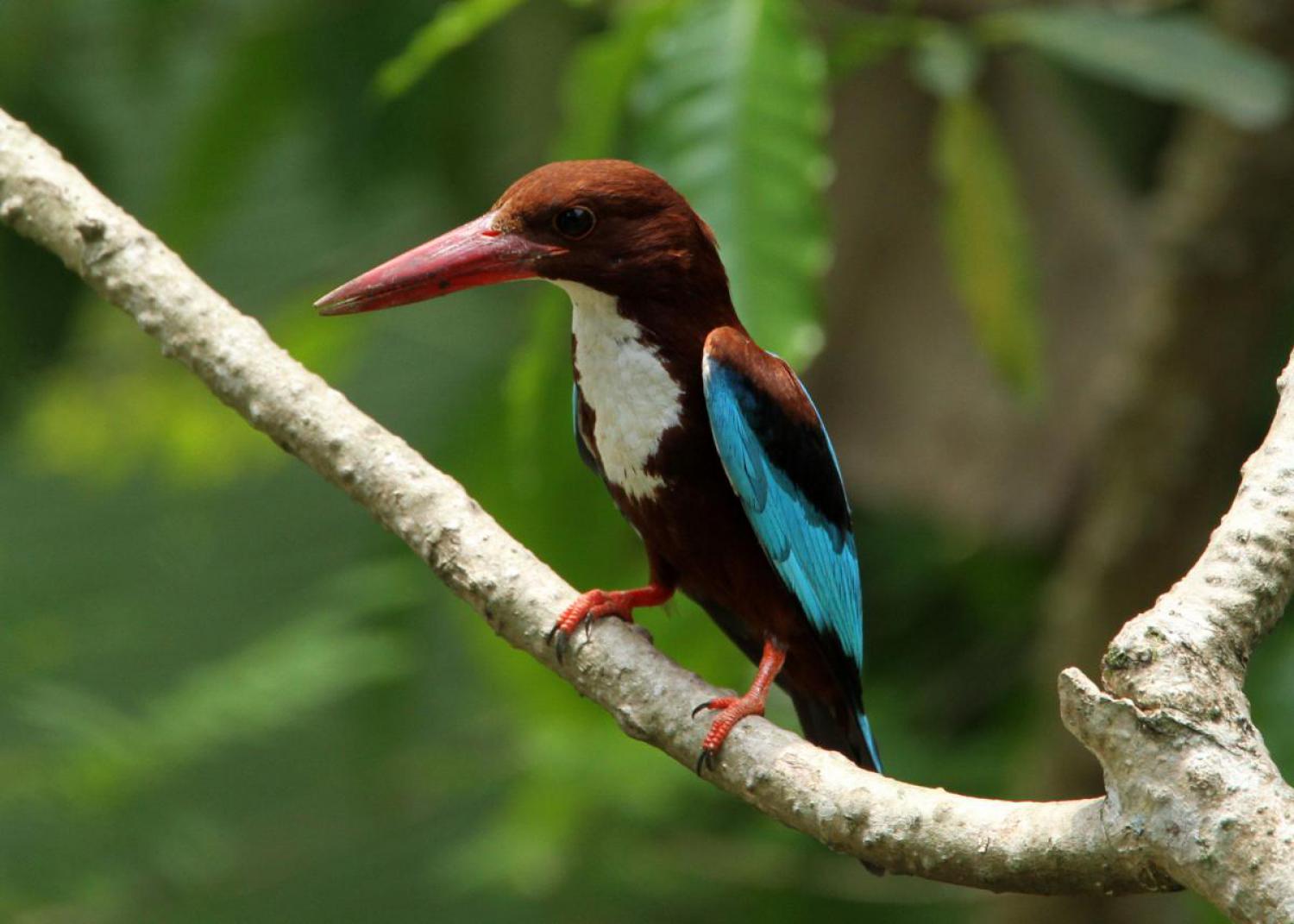Species of Thailand
White-throated kingfisher
Halcyon smyrnensis
Carolus Linnaeus, 1758
In Thai: นกกะเต็นอกขาว
The white-throated kingfisher (Halcyon smyrnensis) also known as the white-breasted kingfisher is a tree kingfisher, widely distributed in Asia from the Sinai east through the Indian subcontinent to the Philippines. This kingfisher is a resident over much of its range, although some populations may make short distance movements. It can often be found well away from water where it feeds on a wide range of prey that includes small reptiles, amphibians, crabs, small rodents and even birds. During the breeding season they call loudly in the mornings from prominent perches including the tops of buildings in urban areas or on wires.
Taxonomy
The white-throated kingfisher is one of the many birds that were first formally described by the Swedish naturalist Carl Linnaeus in 1758 in the tenth edition of his Systema Naturae. He coined the binomial name Alcedo smyrnensis. Linnaeus cites Eleazar Albin's Natural History of Birds published in 1738 which includes a description and a plate of the "Smirna Kingfisher". The present genus Halcyon was introduced by the English naturalist and artist William John Swainson in 1821. Halcyon is a name for a bird in Greek mythology generally associated with the kingfisher. The specific epithet smyrnensis is an adjective for the town of Izmir in Turkey.
Six subspecies are recognised:
- H. s. smyrnensis (Linnaeus, 1758) – south Turkey to north east Egypt, Iraq to northwest India
- H. s. fusca (Boddaert, 1783) – west India and Sri Lanka
- H. s. perpulchra Madarász, 1904 – Bhutan to east India, Indochina, the Malay Peninsular and west Java
- H. s. saturatior Hume, 1874 – Andaman Islands
- H. s. fokiensis Laubmann & Götz, 1926 – south and east China, Taiwan and Hainan
- H. s. gularis (Kuhl, 1820) – Philippines
The race H. s. gularis is sometimes considered as a separate species. Support for this treatment was provided by a molecular study published in 2017 that found that H. s. gularis was more closely related to the Javan kingfisher (H. cyanoventris) than it was to the white-throated kingfisher. The races H. s. perpulchra and H. s. fokiensis are sometimes included in H. s. fusca.
Local names include Baluchistan: aspi chidok; Sindhi: dalel; Hindi: kilkila, kourilla; Himachal Pradesh: neela machhrala; Punjabi: wadda machhera; Bengali: sandabuk machhranga; Assamese: māsorokā, মাছৰোকা; Cachar: dao natu gophu; Gujarati: kalkaliyo, safedchati kalkaliyo; Marathi: khundya; Tamil: vichuli; Telugu: lakmuka, buchegadu; Malayalam: ponman; Kannada: rajamatsi; Sinhalese: pilihuduwa.
Description
This is a large kingfisher, 27 - 28 cm sigfig=3 in length. The adult has a bright blue back, wings and tail. Its head, shoulders, flanks and lower belly are chestnut, and the throat and breast are white. The large bill and legs are bright red. The flight of the white-throated kingfisher is rapid and direct, the short rounded wings whirring. In flight, large white patches are visible on the blue and black wings. Sexes are similar, but juveniles are a duller version of the adult.
This species forms a superspecies with Halcyon cyanoventris and most major works recognize four geographic races. They vary clinally in size, the shades of blue on the mantle which is more greenish in smyrnensis and fusca and more blue or purplish in saturatior. H. s. gularis of the Philippines has only the neck and throat white. It is sometimes treated as a distinct species, H. gularis. Race fusca is found in Peninsular India and Sri Lanka and is slightly smaller, bluer and with a darker brown underside than the nominate race found in northwestern India. Race saturatior is found in the Andaman Islands and is larger with darker brown underparts. Race perpulchra (not always recognized) is found in northeastern India and is smaller than fusca with paler underparts. Albinism has been noted on occasion.
The English of white-throated was introduced since the range is large and geographic adjectives would make the name too restrictive, while the older name of white-breasted would not describe the eastern race which has only the throat white.
The call of this kingfisher is a chuckling chake-ake-ake-ake-ake. They are particularly noisy in the breeding season.
Habitat and distribution
White-throated kingfisher is a common species of a variety of habitats, mostly open country in the plains (but has been seen at 7500 ft in the Himalayas) with trees, wires or other perches. The range of the species is expanding.
This kingfisher is widespread and populations are not threatened. Average density of 4.58 individuals per km2. has been noted in the Sundarbans mangroves.
Feeding and diet
It perches conspicuously on wires or other exposed perches within its territory, and is a frequent sight in south Asia. This species mainly hunts large crustaceans, insects, earthworms, rodents, snakes, fish and frogs. Predation of small birds such as the Indian white-eye, chick of a red-wattled lapwing, sparrows and munias have been reported. The young are fed mostly on invertebrates. In captivity, it has been noted that it rarely drinks water although bathing regularly.
Breeding
The white-throated kingfisher begins breeding at the onset of the Monsoons. Males perch on prominent high posts in their territory and call in the early morning. The tail may be flicked now and in its courtship display the wings are stiffly flicked open for a second or two exposing the white wing mirrors. They also raise their bill high and display the white throat and front. The female in invitation makes a rapid and prolonged kit-kit-kit... call. The nest is a tunnel (50 cm long, but a nest with a 3-foot tunnel has been noted) in an earth bank. The nest building begins with both birds flying into a suitable mud wall until an indentation is made where they can find a perch hold. They subsequently perch and continue digging the nest with their bills. Nest tunnels in a haystack have also been recorded. A single clutch of 4-7 round white eggs is typical. The eggs take 20–22 days to hatch while the chicks fledge in 19 days.
Movements
Birds have sometimes been seen attracted to lights at night, especially during the monsoon season, suggesting that they are partly migratory.
Mortality
With a powerful bill and rapid flight, these kingfishers have few predators when healthy and rare cases of predation by a black kite and a jungle crow may be of sick or injured birds. An individual found dead with its beak embedded into the wood of a tree has been suggested as an accident during rapid pursuit of prey, possibly an Indian white-eye. A few parasites have been noted.
In the 1800s these birds were hunted for their bright feathers that were used to adorn hats. It is the State bird of West Bengal.
This article uses material from Wikipedia released under the Creative Commons Attribution-Share-Alike Licence 3.0. Eventual photos shown in this page may or may not be from Wikipedia, please see the license details for photos in photo by-lines.
Category / Seasonal Status
BCST Category: Recorded in an apparently wild state within the last 50 years
BCST Seasonal status: Resident or presumed resident
Scientific classification
- Kingdom
- Animalia
- Phylum
- Chordata
- Class
- Aves
- Order
- Coraciiformes
- Family
- Alcedinidae
- Genus
- Halcyon
- Species
- Halcyon smyrnensis
Common names
- Thai: นกกะเต็นอกขาว
Subspecies
Halcyon smyrnensis fusca, Pieter Boddaert, 1783
Range: Found in India, Sri Lanka, South China, Taiwan, Sumatra and West Java. Population from Burma to the Greater Sundas were treated under the name perpulchra but are now lumped into fusca. South China and Taiwanese populations are sometimes treated as subspecies fokiensis.
Halcyon smyrnensis gularis, Heinrich Kuhl, 1820
Range: Found in the Philippines.
Halcyon smyrnensis saturatior, Allan Octavian Hume, 1874
Range: Found in the Andaman Islands.
Halcyon smyrnensis smyrnensis, Carolus Linnaeus, 1758
Range: Found in Turkey, Northern and Central Israel, Egypt, Iraq, Pakistan, Afghanistan, northwestern India, China, Taiwan and the Philippines, south of Thailand, West Malaysia, Singapore, Sumatra and Java.
Synonyms
- Alcedo smyrnensis, Carolus Linnaeus (1758)
Conservation status

Least Concern (IUCN3.1)
Photos
Please help us review the bird photos if wrong ones are used. We can be reached via our contact us page.
Range Map

- Amphawa District, Samut Songkhram
- Ao Manao-Khao Tanyong National Park
- Ao Phang-Nga National Park
- Ban Bueng District, Chonburi
- Ban Chang District, Rayong
- Ban Laem District, Phetchaburi
- Ban Lat District, Phetchaburi
- Ban Phai District, Khon Kaen
- Ban Phraek District, Phra Nakhon Si Ayutthaya
- Bang Ban District, Phra Nakhon Si Ayutthaya
- Bang Lang National Park
- Bang Len District, Nakhon Pathom
- Bang Pa In District, Phra Nakhon Si Ayutthaya
- Bang Pahan District, Phra Nakhon Si Ayutthaya
- Bang Phra Non-Hunting Area
- Bang Pu Recreation Centre
- Bangkok Province
- Borabue District, Maha Sarakham
- Bueng Boraped Non-Hunting Area
- Chae Hom District, Lampang
- Chaiya District, Surat Thani
- Chaiyo District, Ang Thong
- Chaloem Phra Kiat District, Saraburi
- Chaloem Phrakiat Thai Prachan National Park
- Chatturat District, Chaiyaphum
- Chiang Dao District, Chiang Mai
- Chiang Dao Wildlife Sanctuary
- Chiang Khong District, Chiang Rai
- Chiang Saen District, Chiang Rai
- Chum Ta Bong District, Nakhon Sawan
- Doi Chong National Park
- Doi Inthanon National Park
- Doi Khun Tan National Park
- Doi Lang
- Doi Lo District, Chiang Mai
- Doi Pha Hom Pok National Park
- Doi Phu Kha National Park
- Doi Suthep - Pui National Park
- Doi Tao District, Chiang Mai
- Erawan National Park
- Fang District, Chiang Mai
- Hala-Bala Wildlife Sanctuary
- Hang Chat District, Lampang
- Hat Chao Mai National Park
- Hat Wanakon National Park
- Hat Yai District, Songkhla
- Hua Hin District, Prachuap Khiri Khan
- Huai Chorakhe Mak Reservoir Non-Hunting Area
- Huai Kha Khaeng Wildlife Sanctuary
- Huai Krachao District, Kanchanaburi
- Huai Talat Reservoir Non-Hunting Area
- Huai Yang Waterfall National Park
- In Buri District, Sing Buri
- Kabin Buri District, Prachinburi
- Kaeng Khoi District, Saraburi
- Kaeng Krachan District, Phetchaburi
- Kaeng Krachan National Park
- Kaeng Krung National Park
- Kaeng Som Maew Queen Sirikit Forest Park
- Kamphaeng Saen District, Nakhon Pathom
- Kantharawichai District, Maha Sarakham
- Kapong District, Phang Nga
- Kham Thale So District, Nakhon Ratchasima
- Khanom District, Nakhon Si Thammarat
- Khao Ang Rue Nai Wildlife Sanctuary
- Khao Banthat Wildlife Sanctuary
- Khao Chong
- Khao Khiao - Khao Chomphu Wildlife Sanctuary
- Khao Khitchakut National Park
- Khao Laem National Park
- Khao Lak - Lam Ru National Park
- Khao Luang National Park
- Khao Nam Khang National Park
- Khao Nang Phanthurat Forest Park
- Khao Phanom Bencha National Park
- Khao Phra - Bang Khram Wildlife Sanctuary
- Khao Phra Thaeo Wildlife Sanctuary
- Khao Sam Roi Yot National Park
- Khao Sanam Prieng Wildlife Sanctuary
- Khao Soi Dao Wildlife Sanctuary
- Khao Sok National Park
- Khao Yai National Park
- Khao Yoi District, Phetchaburi
- Khlong Lan National Park
- Khlong Luang District, Pathum Thani
- Khlong Nakha Wildlife Sanctuary
- Khlong Saeng Wildlife Sanctuary
- Khok Pho District, Pattani
- Khon San District, Chaiyaphum
- Khun Chae National Park
- Khun Korn Forest Park
- Khun Nan National Park
- Khun Tan District, Chiang Rai
- Khung Kraben Non-Hunting Area
- Khura Buri District, Phang Nga
- Ko Chang National Park
- Ko Lanta National Park
- Ko Phayam
- Ko Phra Thong
- Ko Samui District, Surat Thani
- Ko Sichang District, Chonburi
- Kromluang Chumphon Wildlife Sanctuary
- Kui Buri National Park
- Kumphawapi District, Udon Thani
- Laem Pak Bia
- Laem Son National Park
- Lam Nam Kok National Park
- Mae Ai District, Chiang Mai
- Mae Chan District, Chiang Rai
- Mae Fa Luang District, Chiang Rai
- Mae Mo District, Lampang
- Mae Ping National Park
- Mae Poen District, Nakhon Sawan
- Mae Rim District, Chiang Mai
- Mae Sot District, Tak
- Mae Taeng District, Chiang Mai
- Mae Tha, Lampang District, Lampang
- Mae Wong National Park
- Mancha Khiri District, Khon Kaen
- Mu Ko Phetra National Park
- Mueang Buriram District, Buriram
- Mueang Chachoengsao District, Chachoengsao
- Mueang Chaiyaphum District, Chaiyaphum
- Mueang Chiang Mai District, Chiang Mai
- Mueang Chiang Rai District, Chiang Rai
- Mueang Chonburi District, Chonburi
- Mueang Kalasin District, Kalasin
- Mueang Kanchanaburi District, Kanchanaburi
- Mueang Khon Kaen District, Khon Kaen
- Mueang Krabi District, Krabi
- Mueang Lampang District, Lampang
- Mueang Lamphun District, Lamphun
- Mueang Loei District, Loei
- Mueang Lopburi District, Lopburi
- Mueang Maha Sarakham District, Maha Sarakham
- Mueang Nakhon Nayok District, Nakhon Nayok
- Mueang Nakhon Pathom District, Nakhon Pathom
- Mueang Nakhon Ratchasima District, Nakhon Ratchasima
- Mueang Nakhon Si Thammarat District, Nakhon Si Thammarat
- Mueang Nan District, Nan
- Mueang Nonthaburi District, Nonthaburi
- Mueang Pan District, Lampang
- Mueang Pattani District, Pattani
- Mueang Phang Nga District, Phang Nga
- Mueang Phatthalung District, Phatthalung
- Mueang Phayao District, Phayao
- Mueang Phetchabun District, Phetchabun
- Mueang Phetchaburi District, Phetchaburi
- Mueang Phichit District, Phichit
- Mueang Phitsanulok District, Phitsanulok
- Mueang Phuket District, Phuket
- Mueang Ranong District, Ranong
- Mueang Ratchaburi District, Ratchaburi
- Mueang Sa Kaeo District, Sa Kaeo
- Mueang Samut Sakhon District, Samut Sakhon
- Mueang Samut Songkhram District, Samut Songkhram
- Mueang Satun District, Satun
- Mueang Songkhla District, Songkhla
- Mueang Sukhothai District, Sukhothai
- Mueang Suphanburi District, Suphan Buri
- Mueang Surat Thani District, Surat Thani
- Mueang Surin District, Surin
- Mueang Tak District, Tak
- Mueang Trat District, Trat
- Mueang Uttaradit District, Uttaradit
- Nam Nao National Park
- Nam Phong National Park
- Namtok Mae Surin National Park
- Namtok Sam Lan National Park
- Ngao Waterfall National Park
- Non Din Daeng District, Buriram
- Non Thai District, Nakhon Ratchasima
- Nong Bong Khai Non-Hunting Area
- Nong Han Lake
- Nong Phai District, Phetchabun
- Nong Plak Phra Ya – Khao Raya Bangsa Non-Hunting
- Nong Prue District, Kanchanaburi
- Nong Song Hong District, Khon Kaen
- Nong Thung Thong Non-Hunting Area
- Nong Waeng Non-Hunting Area
- Nong Ya Plong District, Phetchaburi
- Nong Yai Area Development Project Under Royal Init
- Omkoi Wildlife Sanctuary
- Op Khan National Park
- Pa Sak Chonlasit Dam Non-Hunting Area
- Pa Sang District, Lamphun
- Pachee River Wildlife Sanctuary
- Pai District, Mae Hong Son
- Pak Chong District, Nakhon Ratchasima
- Pak Kret District, Nonthaburi
- Pak Phli District, Nakhon Nayok
- Pak Thale
- Pak Tho District, Ratchaburi
- Pak Thong Chai District, Nakhon Ratchasima
- Pathio District, Chumphon
- Pha Daeng National Park
- Phaisali District, Nakhon Sawan
- Phan District, Chiang Rai
- Phanat Nikhom District, Chonburi
- Phatthana Nikhom District, Lopburi
- Phayuha Khiri District, Nakhon Sawan
- Phi Phi Islands
- Phimai District, Nakhon Ratchasima
- Pho Prathap Chang District, Phichit
- Phra Nakhon Si Ayutthaya District, Phra Nakhon Si Ayutthaya
- Phu Chi Fa Forest Park
- Phu Khiao Wildlife Sanctuary
- Phu Suan Sai National Park
- Phunphin District, Surat Thani
- Phutthamonthon District, Nakhon Pathom
- Pran Buri District, Prachuap Khiri Khan
- Pran Buri Forest Park
- Ratchasan District, Chachoengsao
- Rattanawapi District, Nong Khai
- Sai Noi District, Nonthaburi
- Sai Yok District, Kanchanaburi
- Sai Yok National Park
- Sakaerat Environmental Research Station
- Salak Pra Wildlife Sanctuary
- Salawin National Park
- Samae San Island
- Samut Prakan Province
- San Kala Khiri National Park
- San Sai District, Chiang Mai
- Sanam Bin Reservoir Non-Hunting Area
- Sanam Chai Khet District, Chachoengsao
- Sathing Phra District, Songkhla
- Sattahip District, Chonburi
- Si Maha Phot District, Prachinburi
- Si Racha District, Chonburi
- Si Satchanalai District, Sukhothai
- Si Satchanalai National Park
- Si Sawat District, Kanchanaburi
- Si Thep District, Phetchabun
- Sikao District, Trang
- Similan Islands
- Sirinat National Park
- Sop Prap District, Lampang
- Sri Nakarin Dam National Park
- Sri Phang-nga National Park
- Su-ngai Kolok District, Narathiwat
- Sung Noen District, Nakhon Ratchasima
- Surin Islands
- Ta Phraya National Park
- Tai Rom Yen National Park
- Taksin Maharat National Park
- Takua Pa District, Phang Nga
- Taphan Hin District, Phichit
- Tat Mok National Park
- Tha Chana District, Surat Thani
- Tha Chang District, Sing Buri
- Tha Sala District, Nakhon Si Thammarat
- Tha Takiap District, Chachoengsao
- Tha Wung District, Lopburi
- Tha Yang District, Phetchaburi
- Thai Mueang District, Phang Nga
- Thalang District, Phuket
- Thale Ban National Park
- Thale Noi Non-Hunting Area
- Tham Pla - Namtok Pha Suea National Park
- Than Sadet - Koh Pha-Ngan National Park
- Thanyaburi District, Pathum Thani
- Thap Lan National Park
- Thawat Buri District, Roi Et
- Thong Pha Phum National Park
- Thung Tako District, Chumphon
- Ton Nga-Chang Wildlife Sanctuary
- Ton Pariwat Wildlife Sanctuary
- Wang Chan District, Rayong
- Wang Mai Forest Restoration Project
- Wang Nam Yen District, Sa Kaeo
- Wang Noi District, Phra Nakhon Si Ayutthaya
- Wat Phai Lom & Wat Ampu Wararam Non-Hunting Area
- Watthana Nakhon District, Sa Kaeo
- Wiang Chai District, Chiang Rai
- Wiang Kaen District, Chiang Rai
- Yan Ta Khao District, Trang
